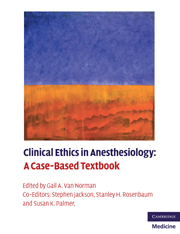Book contents
- Clinical Ethics in Anesthesiology
- Clinical Ethics in Anesthesiology
- Copyright page
- Dedication
- Contents
- Contributors
- Foreword
- Preface
- 1 Consent and refusal
- 2 End-of-life issues
- 3 Pain management
- 4 Research and publication
- 27 Ethics in anesthesiology research using human subjects
- 28 Animal subjects research Part I: Do animals have rights?
- 29 Animal subjects research Part II: Ethics of animal experimentation
- 30 Ethical function of human subjects review boards: a US perspective
- 31 Research with vulnerable persons such as children and prisoners
- 32 The ethics of research on pain and other symptoms for which effective treatments already exist
- 33 Quality improvement initiatives: when is quality improvement actually a form of human subjects research?
- 34 Conflicts of interest in research funding
- 35 Publication ethics: obligations of authors, peer-reviewers, and editors
- 5 Practice issues
- 6 Anesthesiologists, the state, and society
- Index
31 - Research with vulnerable persons such as children and prisoners
from 4 - Research and publication
Published online by Cambridge University Press: 05 March 2012
- Clinical Ethics in Anesthesiology
- Clinical Ethics in Anesthesiology
- Copyright page
- Dedication
- Contents
- Contributors
- Foreword
- Preface
- 1 Consent and refusal
- 2 End-of-life issues
- 3 Pain management
- 4 Research and publication
- 27 Ethics in anesthesiology research using human subjects
- 28 Animal subjects research Part I: Do animals have rights?
- 29 Animal subjects research Part II: Ethics of animal experimentation
- 30 Ethical function of human subjects review boards: a US perspective
- 31 Research with vulnerable persons such as children and prisoners
- 32 The ethics of research on pain and other symptoms for which effective treatments already exist
- 33 Quality improvement initiatives: when is quality improvement actually a form of human subjects research?
- 34 Conflicts of interest in research funding
- 35 Publication ethics: obligations of authors, peer-reviewers, and editors
- 5 Practice issues
- 6 Anesthesiologists, the state, and society
- Index
Summary
Keywords
- Type
- Chapter
- Information
- Clinical Ethics in AnesthesiologyA Case-Based Textbook, pp. 185 - 192Publisher: Cambridge University PressPrint publication year: 2010
- 1
- Cited by

